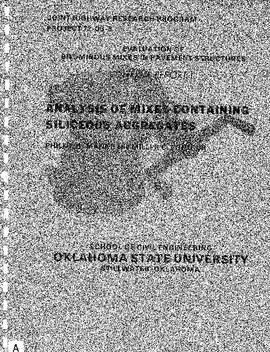| dc.creator | Manke, Phillip G. | |
| dc.creator | Ford, Miller C. Jr. | |
| dc.date.accessioned | 2019-03-08T19:47:29Z | |
| dc.date.available | 2019-03-08T19:47:29Z | |
| dc.date.issued | Jun-73 | |
| dc.identifier.govdoc | FHWA-OK | |
| dc.identifier.other | Oklahoma Department of Transportation State Planning and Research | |
| dc.identifier.uri | https://hdl.handle.net/11244/317581 | |
| dc.description.abstract | Sufficient heat can be transported from the surrounding ground to a bridge deck by heat pipes to both reduce the number of freeze-thaw cycles and to reduce the time during which the surface is below freezing. In a computer model of the thermal response of a bridge during a sample month, the use of heat pipes spaced six inches apart reduced the number of freeze-thaw cycles by 58% and the time that the surface was below freezing by 87%. While even higher performance is possible, economic and structural constraints will certianly preclude the elimination of all freezing. A screen covered groove heat pipe using ammonia as a working fluid appears to yield the best performance. Computer models are presented to analyse the performance of such heat pipes and to predict the thermal response of a highway bridge with heat pipes to either idealized or actual meteorological conditions. Recommendations are made for further work. | |
| dc.format.extent | 121 pages | |
| dc.format.extent | 21,867,265 bytes | |
| dc.format.medium | application.pdf | |
| dc.language | en_US | |
| dc.relation.ispartofseries | No | |
| dc.relation.requires | Adobe Acrobat Reader | |
| dc.title | Evaluation of bituminous mixes in pavement structures interim report I - Analysis of mixes containing siliceous aggregates | |
| dc.type | Technical Report | |
| dc.description.version | Interim Report I | |
| dc.description.peerreview | No | |
| dc.type.material | text | |
| dc.contributor.sponsor | Oklahoma Department of Transportation. Materials and Research Division. Office of Research & Implementation | |
